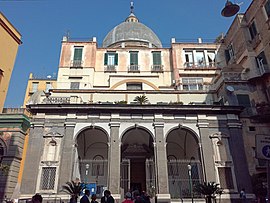Chiesa dell'Ascensione a Chiaia
| Chiesa dell'Ascensione a Chiaia ( Church of the Assumption of Chiaia ) |
|
|---|---|
| Patronage : |
Ascension Day ; Archangel Michael , St. Anna and Peter Celestine |
| Order : | Coelestiner |
| Address: | Piazzetta Ascensione 15, 80100 Naples |
Coordinates: 40 ° 50 ′ 10.4 " N , 14 ° 14 ′ 3.4" E
The Chiesa dell'Ascensione a Chiaia (German: Assumption Church of Chiaia ) is a baroque church in Naples in the Chiaia district . It is located at the Piazzetta Ascensione named after her.
history
A first church of this name and a convent of Celestine monks was built on the ancient Via Puteolana in the 14th century at the request of Nicola Alunno d'Alife, Chancellor under Robert of Anjou .
The current building was built in the 17th century as a foundation by the Portuguese grain trader Michele Vaaz (aka Miguel Vaz) de Andrade, Count of Mola. According to a legend, he was in custody by the viceroy , the Duke of Osuna, when on the eve of the Ascension of Christ , on May 3, 1617, Saint Peter Celestine appeared to him in a dream and held out his hand. The next day the count escaped and found a three-year asylum in the old and already rather dilapidated Church of the Assumption . He was eventually acquitted in a subsequent process.
Out of gratitude he left the order a large sum of money after his death, which was intended for the construction of a new church. This should be dedicated to the Archangel Michael and the Saints Anna (the name of his wife) and Petrus Celestinus. The church was originally intended as a private chapel for the Vaaz family.
The new building was entrusted to Cosimo Fanzago and completed in 1645. The decoration of the interior, in which Luca Giordano was also involved, dragged on for a few years.
After the Vaaz family became impoverished, they gave the church to the Celestine monks. These demolished the old, original church and opened the new one for general use.
In 1767 the dome was renewed by Matteo Tramontano.
During the French rule under Joachim Murat at the beginning of the 19th century, the monastery was closed and used for military purposes. The church itself passed into the hands of the Congrega di Santa Maria a Cappella Nuova .
In 1850 the Archbishop of Naples succeeded in restoring the church to its original religious purpose by declaring it a parish ( parrocchia ).
description
In front of the actual church is a three-arched open portico , which is structured by smooth Doric pilasters from Piperno .
The interior has the shape of a Greek cross and is also given rhythm by pilasters made of piperno, which, however, are fluted and of a Corinthian order. Under the beams a rich with runs stucco decorated Fries . The polychrome marble decoration of the main altar was created by Aniello Gentile in 1738, the two matching side altars by Giuseppe Bastelli in 1754.
The room is dominated by two altarpieces by Luca Giordano from 1657: On the main altar you can see the Archangel Michael fighting the rebellious angels , on the right altar St. Anne with the Virgin Mary as a child . There is a relief with the resurrection of Christ above the main altar .
Other paintings are by Alfonso di Spigna, including St. Peter Celestinus rejecting the papal crown , and frescoes on the side walls of the presbytery with Hagar in the desert and Abraham and the angels . In the pendentives of the dome you can see frescoes with the four evangelists .
In the sacristy , Giovan Battista Lama created a four-part cycle about the life of Saint Peter Celestine around 1730 .
literature
- Vincenzo Regina: Le chiese di Napoli. Viaggio indimenticabile attraverso la storia artistica, architettonica, letteraria, civile e spirituale della Napoli sacra. Newton e Compton editore, Naples 2004.
See also
Web links
- The “Chiesa dell'Ascensione a Chiaia” in Naples on the “napoligrafia” website , viewed on March 9, 2019 (Italian; also source of this article)
- Andrea Andolfi: “Storia e misteri della Chiesa dell'Ascensione a Chiaia”, May 30th 2017, on the website “www.storienapoli.it” , viewed on March 9th, 2019 (Italian; also source of this article)
- "Chiesa dell'Ascensione a Chiaia" on Facebook , as seen on March 9, 2019 (Italian)
- "Chiesa dell'Ascensione a Chiaia" on the website "www.inspirock.com" , viewed on March 9, 2019 (Italian)
- "Chiesa dell'Ascensione a Chiaia" on the website "www.weagoo.com" , viewed on March 9, 2019 (Italian)
Individual evidence
- ↑ Address on the website "www.touringclub.it" , viewed on March 9, 2019 (Italian; also source of this article)
- ↑ a b c d e f g h i j History of the “Chiesa dell'Ascensione a Chiaia” in Naples on the website “napoligrafia” , sub-item: “ storia ed architettura ”, viewed on March 9, 2019 (Italian; also source of present article)
- ↑ a b c d e f g “Storia e misteri della Chiesa dell'Ascensione a Chiaia”, May 30, 2017, on the website “www.storienapoli.it” , viewed on March 9, 2019 (Italian; also source of this Article)
- ↑ a b c d e f Information about the interior of the "Chiesa dell'Ascensione a Chiaia" in Naples on the website "napoligrafia" , sub-item: " Interno ", viewed on March 9, 2019 (Italian; also source of this article)



